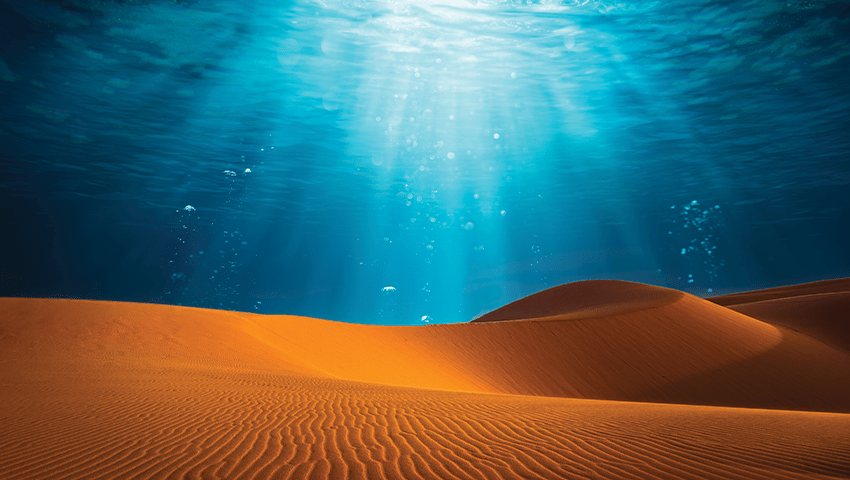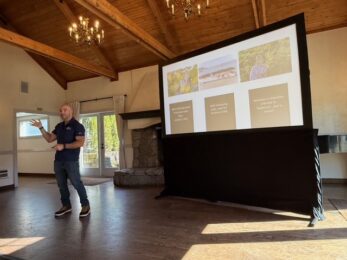But in Las Vegas, the glass is half full, not half empty
You wouldn’t know it by the news out of California earlier this winter, but that state’s historic drought continues. It’s not alone. In mid-2022, more than 32 percent of land in the U.S. West was classified as experiencing extreme or exceptional drought.
Unfortunately, the world follows. A recent United Nations report says 5 billion people, or about two-thirds of the global population, will face water shortages by 2050 due to climate change.
Back in the American West, Nevada is one of the most severely drying places. And that means not just for its residents but also for the 40 million visitors annually, many of them meeting attendees, in the neon-lit oasis of Las Vegas. Ninety percent of Las Vegas’ water supply comes from Lake Mead, the country’s largest manmade reservoir, courtesy of the Colorado River.
During the last two-plus years, Lake Mead has sunk 60 feet, to just above 1,000 feet. Las Vegas’ longtime water intake is already high and dry, but a new one at the elevation of 860 feet was rushed to completion in 2015—and should give the thirsty city about six more years of water should the drought continue unabated. This, despite Nevada’s loss of 8 percent of its Lake Mead water allotment (or 8.1 billion gallons) this year.
In its announcement of this reduction, the U.S. Department of the Interior cited “the 23-year ongoing historic drought and low runoff conditions in the Colorado River Basin.”
Vegas Bets on Conservation
Does this mean you should stop filling up water glasses at your Las Vegas events or limiting ice cubes in drinks? Or, worse, bypass Las Vegas as a meeting destination so that its residents can slake their thirsts?
Read More: Las Vegas: It Takes an Events Village
Absolutely not, given all the measures the city is taking to reduce its water waste and use.
“The Strip accounts for but 5 percent of the area’s total water usage.”
Some of these measures date as far back as the 1950s. Indoor water use, for example. Nearly every drop gets reclaimed. “We treat that water to clean water standards, then return it to Lake Mead,” Bronson Mack, public information officer for Las Vegas Valley Water District, recently assured CNN. “Even if you don’t drink that glass of water…they’re going to dump that down the drain, and all of that water gets reclaimed.” Dishwasher water to clean that glass is purified and sent back to the lake, too.
Every gallon returned to Lake Mead allows another gallon to be piped out of the lake without counting against the water district’s allocation.
Over-the-top excess may be synonymous with the Vegas brand, yet The Strip accounts for but five percent of the area’s total water usage. And as Mack notes: “We could turn on every shower and every sink in every hotel room on the Las Vegas Strip, and it wouldn’t increase the amount of water we deplete from the Colorado River.” Because it’s all recycled.
Other Watery Issues
But what about those extravagant water features at some hotels? Those meandering canals in The Venetian Resort, for instance? Well, that water is recirculated, and if any portion needs to be emptied for maintenance, that water is recycled back to the lake.
Still, water loss through evaporation for such features is real—an estimated 48 gallons per sq. ft. per year—and the water district is said to be considering a ban on new ornamental water displays at resort hotels unless they are completely indoors and supplied by a privately owned water source.
Read More: Year of the Sustainable RFP
The famous fountains at the front of Bellagio Resort & Casino, which sway with music and light, to cite another example, are filled from a privately owned groundwater from a well rather than Lake Mead water. Bellagio is owned by MGM Resorts, which has set a 2025 goal of reducing water used at its properties by 33 percent (from a 2007 baseline), mostly by replacing grass with drought-tolerant landscaping. By 2019, MGM says, these efforts had saved 5 billion gallons of water.
Other Vegas hotels have reduced water consumption by upgrading HVAC systems, which do use water.
Last year the water district banned grass at all new properties in Las Vegas Valley except for schools, parks and cemeteries. Single-family homes built after 2003 cannot have grass in front yards and only in limited spaces elsewhere.
“Saving water is desert living, and we are in the middle of the Mojave Desert,” in Mack’s words. “Our community has been a city in the desert, and now we are finally becoming a desert city.”
This article appears in the March 2023 issue. You can subscribe to the magazine here.




